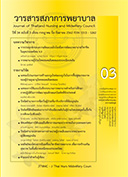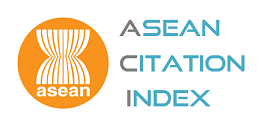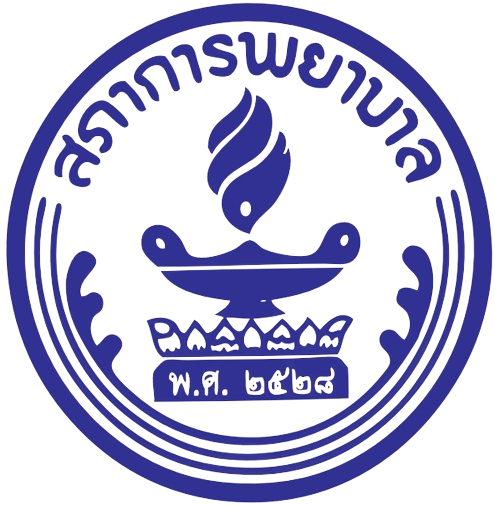ผลของโปรแกรมการสร้างแรงจูงใจต่อแรงจูงใจในการฟื้นฟูสมรรถภาพของผู้ป่วยสูงอายุโรคหลอดเลือดสมอง
คำสำคัญ:
โปรแกรมการสร้างแรงจูงใจ, แรงจูงใจในการฟื้นฟูสมรรถภาพ, ผู้สูงอายุโรคหลอดเลือดสมองบทคัดย่อ
วัตถุประสงค์การวิจัย: เพื่อศึกษาผลของโปรแกรมการสร้างแรงจูงใจต่อแรงจูงใจในการฟื้นฟูสมรรถภาพของผู้ป่วยสูงอายุโรคหลอดเลือดสมอง
การออกแบบวิจัย: การวิจัยกึ่งทดลอง แบบ 2 กลุ่ม วัดก่อนการทดลองและ 1 สัปดาห์ และ2 สัปดาห์หลังการทดลอง
วิธีการดำเนินการวิจัย: กลุ่มตัวอย่างเป็นผู้สูงอายุโรคหลอดเลือดสมองถูกคัดเลือกตามเกณฑ์ การคัดเข้า จากผู้ที่เข้ารับการรักษาที่โรงพยาบาลระดับตติยภูมิ จำนวน 2 แห่ง จำนวน 44 คน แบ่งเป็นกลุ่มทดลองและกลุ่มควบคุมกลุ่มละ22คนจับคู่อายุของกลุ่มตัวอย่างผู้วิจัยดำเนินการในกลุ่มควบคุมก่อนแล้วดำเนินการจับคู่ในกลุ่มทดลองให้คล้ายกับกลุ่มควบคุมกลุ่มทดลองได้รับการพยาบาลปกติร่วมกับโปรแกรมการสร้างแรงจูงใจ เป็นระยะเวลา 2สัปดาห์ เก็บข้อมูลด้วย แบบสัมภาษณ์ข้อมูลส่วนบุคคล แบบสอบถามแรงจูงใจในการฟื้นฟูสมรรถภาพของผู้ป่วยโรคหลอดเลือดสมอง วัดแรงจูงใจในการฟื้นฟูสมรรถภาพ 1และ 2สัปดาห์หลังการทดลอง วิเคราะห์ข้อมูลด้วยสถิติเชิงพรรณนา Chi-Square, Mann-Whitney U Test และ Repeated Measure one-way ANOVA
ผลการวิจัย: แรงจูงใจในการฟื้นฟูสมรรถภาพหลังสิ้นสุดโปรแกรมสัปดาห์ที่ 2 ระหว่างกลุ่มทดลองและกลุ่มควบคุมแตกต่างกันอย่างมีนัยสำคัญทางสถิติ (p < .05) ส่วนกลุ่มทดลองแรงจูงใจฯ ก่อนการทดลองและสัปดาห์ที่ 1 แตกต่างกันอย่างมีนัยสำคัญทางสถิติ (p < .05) แต่หลังการทดลองระหว่างสัปดาห์ที่ 1 และสัปดาห์ที่ 2 ไม่แตกต่างกัน
ข้อเสนอแนะ: โปรแกรมนี้มีผลต่อการสร้างแรงจูงใจในการฟื้นฟูสมรรถภาพของผู้ป่วยสูง อายุโรคหลอดเลือดสมอง พยาบาลควรนำโปรแกรมการสร้างแรงจูงใจไปประยุกต์ใช้กับผู้ป่วยสูง อายุโรคหลอดเลือดสมองที่เข้ารับการฟื้นฟูสมรรถภาพ
Downloads
References
2. Department of Disease Control. Bureau of NonCommunicable Diseases. World Stroke Day 2016 [Internet]. 2016. [Cited 2017 March 25]. Available from: https://thaincd.com/2016/media-detail. php?id=12303&tid=&gid=1-015-001 (in Thai)
3. KitisomprayoonkulW.Strokerehabilitation.Bangkok: Danex Intercorperation; 2015. (in Thai)
4. Saksri W, Tananupabpaisal S. Rehabilitation in hemiparesis handbook. Bangkok: Amarin Printing & Publishing; 2009. (in Thai)
5. Verheyden G, Nieuwboer A, De Wit L, Thijs V, Dobbelaere J, Devos H, et al. Time course of trunk, arm,leg,andfunctionalrecoveryafterischemicstroke. Neurorehabil Neural Repair 2008;22(2): 173-9.
6. Van Dalen JW, Van Charante EPM, Nederkoorn PJ, Van Gool WA, Richard E. Poststroke apathy. Stroke
2008;44:851-60.
7. Thongcharoen W. Physical and physiological changes in elderly. In: Thongcharoen W, editor. Science and
art in gerontological nursing. 2nd ed. Bangkok: N P Press; 2015. p. 45-54. (in Thai)
8. Harris AL, Elder J, Schiff ND, Victor JD, Goldfne AM.Post-strokeapathyandhypersomnialeadtoworse
outcomes from acute rehabilitation. Transl Stroke Res 2014;5(2):292-300.
9. European Stroke Initiative Executive Committee. Europeanstrokeinitiativerecommendationsforstroke
management-update 2003. Cerebrovasc Dis 2003; 16:331-7.
10. Thailand Nursing and Midwifery Council. Nursing and midwife nursing act 2005 and edited by nursing and midwife act (issue 2) 1997. 2nd ed. Nonthaburi: Siriyod Printing; 2008. (in Thai)
11. Ryan RM, Deci EL. Self-determination theory and the facilitation of intrinsic motivation, social development, and well-being. Am Psychol 2000; 55(1):68-78.
12. BrainRehabilitationGroup.ThaiGeriatricDepression Scale. Siriraj Med J 1994;46(1):1-6. (in Thai)
13. Ministry of Public Health. Institute of Geriatric Medicine Ministry. Mini-Mental State Examination
Thail 2002. Nonthaburi: Ministry of Public Health; 1999. (in Thai)
14. Thompson S. Effect of the rehabilitation setting on motivation and clinical outcomes post stroke-a pilot study [dissertation]. New Zealand: University of Otago; 2012.42
15. Glass GV. Primary, secondary, and meta-analysis of research. Educ Researcher 1976;5:3-8.
16. Cohen J. Statistical power analysis for the behavior sciences. 2nd ed. New York: Lawrence Erlbaum Associates; 1988.
17. Adunwattanasiri P. The effectiveness of brain training program on attention and memory in acute ischemic
strokepatients[dissertation].NakhonPathom:Mahidol University; 2009. (in Thai)
18. White GN, Cordato DJ, Rourke FO, Mendis RL., GhiaD,ChanD.Validationofthestrokerehabilitation motivation scale: a pilot study. Asian J Gerontol Geriatr 2012;7(2):80-7.
19. Srisatidnarakul B. The methodology in nursing research. 5th ed. Bangkok: Chulalongkorn University;
2010. (in Thai)
20. Polit DF, Beck CT. Essential of nursing research: appraising evidence for nursing practice. 7th ed.
Philadelphia: Wolters Kluwer Health; 2010.
21. TeixeiraE,CarracaEV.,MarklandD,SilvaMN,Ryan, RM.Exercise,physicalactivity,andself-determination
theory: a systematic review. Int J Behav Nutr Phy 2012;9(78):1-30.
22. Fortier MS, Duda JL, Guerin E, Teixeira PJ, Pedro J. Promoting physical activity: development and testing
of self-determination theory-based interventions. Int J Behav Nutr Phy 2012;2:9-20.
23. Ryan RM, Williams GC, Patrick H, Deci EL. Selfdeterminationtheoryandphysicalactivity:thedynamics of motivation in development and wellness. Hell J Psychol 2009;6:107-24.
24. Jorgensen SW, Bice MR, Unruh S, Akehi K, Crockett H, Mcreynolds J. Motivation of shoulder surgery patients for rehabilitation. Int J Exerc Sci 2017;10(2):234-45.
25. Rahman RJ, Hudson J, Thøgersen-Ntoumani C, Doust JH. Motivational processes and well-being in
cardiac rehabilitation: a self-determination theory perspective.PsycholHealthMed2015;20(5):518-29.
26. Chang LP. Development of motivation to exercise in patients with parkinson‘s disease: an application
ofselfdeterminationtheory[dissertation].Philadelphia: Temple University; 2012.
27. Yu HF, Guo NW, Chen HY, Liang CP. Factors affecting stroke patients’ motivations for rehabilitation.
Kaohsiung J Med Sci 1993;9(5):305-16.
28. ShawKL.Patienteducation,motivation,compliance, and adherence to physical activity, exercise, and
rehabilitation. In: David MJ, James ZE, Quillen WS, Manske RC, editors. Pathology and intervention in
musculoskeletalrehabilitation.2nded.China:Elsevier;2016. p. 1-24.
29. Nicholson S, Sniehotta FF,Van Wijck FV, Greig CA, Johnston M, McMurdo MET. A systematic review
of perceived barriers and motivators to physical activityafterstroke.IntlJStroke2013;8(5):357-64.
30. Zielińska DA, Rajtar-Zembaty AM, Starowicz-Filip A. The influence of cognitive, emotional and social
factors on motivation for rehabilitation in patients after stroke. Neuropsychiatria i Neuropsychologia.
2015;10(2):64-8.
31. CarronAV,HausenblasHA,MackD.Socialinfluence and exercise: a meta-analysis. J Sport Exerc Psychol 1996;18:1-6.







